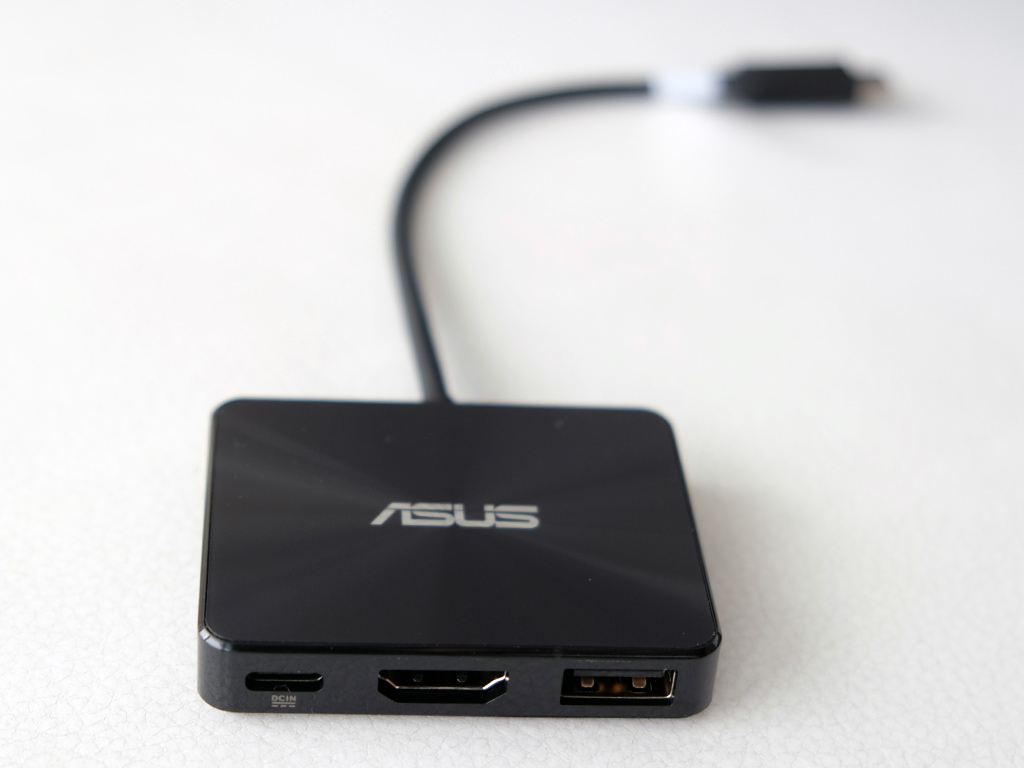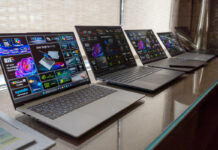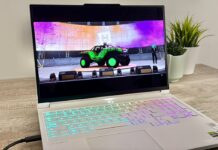
Asus ZenBook 3 Deluxe Specs
|
Asus adds some extra screen size, along with key additions inside and out to improve upon the original and give this ZenBook 3 its Deluxe name.
Windows PC laptops seem to be going through something of a renaissance these days. Better design, better components and slicker form factors are breathing some life into the category. Asus turned some heads with the ZenBook 3 last year, which was among the most attractive PC notebooks I had used up that point.
The Deluxe carries on the same look and feel, yet adds more in different areas to make it better. While none are especially earth-shattering, the sum of those additions does give this unit its own identity.
Design
Making the ZenBook 3 Deluxe thin and light was already the underlying idea, so despite a slightly heavier body, the same principle applies. The weight gain (total 1.1 kg) is understandable because of the larger screen, stretched out now to 14-inches from the previous 12.5-inches.
It’s still 1080p, so the physical stretch doesn’t come with a resolution bump, which might irk users looking to pack in more pixels. It’s a safe resolution to go with, but I would have liked to see a 2K (1440p) screen, or something in that ballpark, to match the elegant build quality. Asus didn’t include touch-sensitivity, so this is still the standard laptop it was before.
It is essentially the same unibody frame—a smart move to stick with it. I know beauty is subjective, but I don’t think I’m out of line calling this objectively attractive. It’s sleek, stylish and tastefully accented with the right colours. Asus didn’t change those, either. If not for the size difference, it would be tough to immediately tell the Deluxe apart from its predecessor.
The backlit keyboard mostly maintains its look, except the keys drop deeper with each stroke. I noted the flatter keys when reviewing the previous model, and while they didn’t bother me too much, Asus did the right thing by elevating them here. Typing feels more natural, with a smoother transition between keys too. I wrote this review on the ZenBook 3 Deluxe and noticed it right away.
The same fingerprint sensor is back on the same trackpad. No major improvements necessary there, given how smooth and seamless it felt once I truly adjusted to it. Windows gestures work well here, so getting around shouldn’t be difficult.
Internally, the Deluxe runs on an 8th-gen Intel Core i7 (Kaby Lake Refresh) 1.8GHz quad-core processor with 16GB of RAM and 500GB SSD drive. It’s an upgrade over last year’s Kaby Lake chipset, but comes with a couple of compromises I’ll point out later.
That snazzy polyester carrying case makes a return, with the same magnetic clasp to keep it closed.

Ports and the dongle life
 Asus went a little frugal with the ports in the ZenBook 3, which it rectifies with the Deluxe. Now, you get three USB-C ports instead of one, plus the headphone jack. Two of those USB-C ports are Thunderbolt 3, making them really efficient at transferring data back and forth. Plug in an external monitor or any other peripheral, and the Deluxe shouldn’t skip a beat.
Asus went a little frugal with the ports in the ZenBook 3, which it rectifies with the Deluxe. Now, you get three USB-C ports instead of one, plus the headphone jack. Two of those USB-C ports are Thunderbolt 3, making them really efficient at transferring data back and forth. Plug in an external monitor or any other peripheral, and the Deluxe shouldn’t skip a beat.
Wisely, Asus also threw in the multi-port hub in the box. This dongle has another USB-C port, an HDMI port and a USB 3.0 port. It’s missing a memory card reader, but you can probably get around that by getting a USB adapter to slide the card in that way.
That dongle becomes an integral part of the whole package. The mass industry move to USB-C is still underway, and so, connecting any number of peripherals or devices using regular USB or HDMI comes into play. Asus included a pocket in the polyester case specifically for the dongle hub.
Performance
 I was amused at how Cortana came to life when I first turned on the Deluxe. Like a hostess signing me up to participate in a contest, she explained each step of the process. I personally didn’t need the guidance, but could see how this would get things off on the right foot.
I was amused at how Cortana came to life when I first turned on the Deluxe. Like a hostess signing me up to participate in a contest, she explained each step of the process. I personally didn’t need the guidance, but could see how this would get things off on the right foot.
Cortana is a useful tool once you get to learn how to utilize it as a voice assistant and resource. It can look things up, both on the machine’s internal storage, or on the web. It can warn of low battery, or set reminders to do things. I’ve used it before many times, but feel it only gets better.
The Deluxe didn’t really surprise me with its performance. Asus went with a better chipset, yet also one that demands more to power through. I could feel the unit getting hot whenever I really put it to work. It didn’t slow down until really pushed, though it depended on what was driving it. For example, Microsoft Office ran without a single problem. Multiple apps, documents—no problem.
Even constantly surfing with a web browser didn’t make it start to crawl. When I started playing video or editing photos, I could feel the temperature rise. Granted, I’m doing this with several apps open that are active, but even if I was doing video editing with a browser open, the Deluxe needed to push.
Admittedly, I wouldn’t view the ZenBook 3 Deluxe as a standout laptop for media editing. It’s capable of doing it, but not made to do it all. Resource-intensive programs that tax the processor will show the device’s weaknesses. Despite the many variables to that, I can say that you will likely take longer to process or convert video files here than you would on other laptops.
Software
I realize I’m straddling a line here, but I want to be cognizant of the line the Deluxe walks. It’s a powerful laptop. The 16GB of RAM simplifies multitasking, and 500GB of SSD storage is always nice. Still, there are some boundaries.
I noted demanding video-editing applications, but I would throw gaming in there too. The ZenBook 3 Deluxe is categorically not a gaming machine. Casual games are fine, and anything else that doesn’t need a truckload of graphics power should run well. Just forget anything best reserved for a gaming laptop.
Thankfully, Asus maintained its decision to keep the bloatware away. There were still a few preloaded apps, but nary an Asus stamp on Windows, otherwise.
Microsoft Office is already installed, along with all the other Microsoft staples you’d expect in a Windows 10 machine. Overall, though, I felt little difference between this laptop and a Surface when initially wading through the software and settings.

Battery life
The ZenBook 3 Deluxe’s battery life is a case of two batteries, depending on how you use it. The newer processor is certainly more efficient, sipping less whenever it’s not asked to do much. Doing that, I got an extra two hours compared to the previous model, taking me to a total of just under 10 hours.
The gap closed whenever the processor really pushed and the heat rose. I managed maybe 45 extra minutes with comparable usage from last year. All told, I was closer to six or seven hours in those circumstances.
It’s a big difference for sure, which is why I can’t pinpoint a battery life number, only a range. What you do on the Deluxe determines how much longer it can last, plain and simple.
Incidentally, the 1080p display probably helps here. Had Asus gone with a larger resolution, that would have affected battery life in some form too.
Final Thoughts
When I reviewed the previous ZenBook 3, I mused about its identity as a productivity device or fancy toy. It could’ve gone, either way. The Deluxe doesn’t change that paradigm in a significant way because it’s not built to do everything. Producing documents and editing photos is much easier on it than mashing up video and gaming intensively for hours.
Because of its price and its premium build, knowing what you want to do with it is important. There’s a lot more you can do than what you can’t. If you can live without what it doesn’t do all that well, then you will like how this laptop feels.
The Asus ZenBook 3 Deluxe is available now.




I was just searching for the best Asus laptop and found this awesome in-depth review article. Thank you so much for sharing keep it up 🙂
I am using Asus ZenBook from very long. This is one of the best laptops. The only issue some times is the battery backup other than this , This laptop superb!
I am using Asus ZenBook from very long. This is one of the best laptops. I would recommend this to all.
seriously this is amazing information admin 🙂 i really appreciate your efforts thanks alot 🙂
This is a powerful machine. I wish it was available here in India.
Comments are closed.